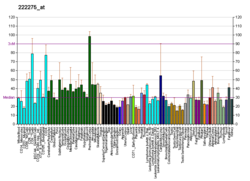A request that this article title be changed to Mitochondrial ribosomal protein S30 is under discussion . Please do not move this article until the discussion is closed. |
| MRPS30 | |||||||||||||||||||||||||||||||||||||||||||||||||||
|---|---|---|---|---|---|---|---|---|---|---|---|---|---|---|---|---|---|---|---|---|---|---|---|---|---|---|---|---|---|---|---|---|---|---|---|---|---|---|---|---|---|---|---|---|---|---|---|---|---|---|---|
| |||||||||||||||||||||||||||||||||||||||||||||||||||
| Identifiers | |||||||||||||||||||||||||||||||||||||||||||||||||||
| Aliases | MRPS30 , MRP-S30, PAP, PDCD9, S30mt, mitochondrial ribosomal protein S30 | ||||||||||||||||||||||||||||||||||||||||||||||||||
| External IDs | OMIM: 611991; MGI: 1926237; HomoloGene: 9607; GeneCards: MRPS30; OMA:MRPS30 - orthologs | ||||||||||||||||||||||||||||||||||||||||||||||||||
| |||||||||||||||||||||||||||||||||||||||||||||||||||
| |||||||||||||||||||||||||||||||||||||||||||||||||||
| |||||||||||||||||||||||||||||||||||||||||||||||||||
| |||||||||||||||||||||||||||||||||||||||||||||||||||
| |||||||||||||||||||||||||||||||||||||||||||||||||||
| Wikidata | |||||||||||||||||||||||||||||||||||||||||||||||||||
| |||||||||||||||||||||||||||||||||||||||||||||||||||
28S ribosomal protein S30, mitochondrial is a protein that in humans is encoded by the MRPS30 gene. [5] [6] [7]
Mammalian mitochondrial ribosomal proteins are encoded by nuclear genes and help in protein synthesis within the mitochondrion. Mitochondrial ribosomes (mitoribosomes) consist of a small 28S subunit and a large 39S subunit. They have an estimated 75% protein to rRNA composition compared to prokaryotic ribosomes, where this ratio is reversed. Another difference between mammalian mitoribosomes and prokaryotic ribosomes is that the latter contain a 5S rRNA. Among different species, the proteins comprising the mitoribosome differ greatly in sequence, and sometimes in biochemical properties, which prevents easy recognition by sequence homology. This gene encodes a 28S subunit protein that is similar to the chicken pro-apoptotic protein p52. Transcript variants using alternative promoters or polyA sites have been mentioned in the literature but the complete description of these sequences is not available. [7]





